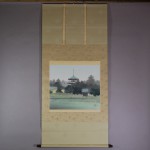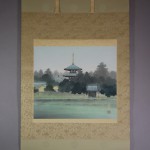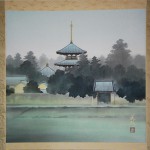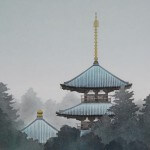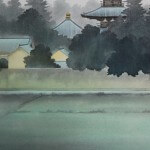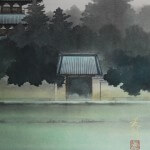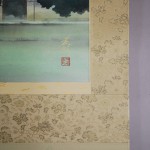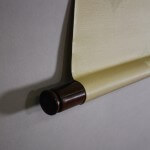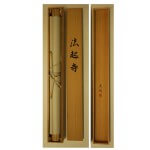Products Lineup
News / Blog
Other Menus
Kakejiku Hanging Scroll: The Hokki-ji Temple / Tatsurou Shima - Hokki-ji
- Product ID
- 0033
- Name
- Tatsurou Shima
- Profile
1955-
Japanese-style painter- Size
- 800mm x 1560mm
- Roller End Material
- Red sandalwood
- Material of the Work
- Japanese paper
- Price
- JPY 180,000
- Stock Condition
- In stock
- Payment: Click the Paypal Mark
- Duty and Taxes
Import duty and taxes are beyond our control and may apply to your shipment. Please noted that these fees are the responsibility of the buyer.
- Description
The Hōki-ji (also pronounced as Hokki-ji) is a temple of the Shōtoku sect located at Okamoto, Ikaruga Town, Ikoma County, Nara Prefecture. Sometimes the temple is counted as one of the seven major temples Prince Shōtoku erected, but in fact, the temple was completed several decades after Prince Shōtoku’s death. In the Ikaruga area, where World Heritage the Hōryū-ji Temple is located, in addition to the Hōki-ji temple, there are many other old temples that have connection with Prince Shōtoku, such as the Hōrin-ji Temple (Ikaruga Town), the Chūgū-ji Temple, and others. Due to this fact, we can see that this area was a center of the Buddhist culture since ancient times. Among the original structures, the only building in existence is the three storey pagoda. The Three-Storey Pagoda of Hokki-ji Temple was built early in the eighth century. The pagoda that measures 24 m tall is the oldest three storey pagoda in Japan. It is also said to be the largest three-storey pagoda in Japan, except for Yakushi-ji Tōtō (East Pagoda of Yakushi-ji Temple) that has a peculiar style. This pagoda is a national treasure.
There are not many visitors because the Hokki-ji Temple is far from a sight-seeing area. However, it has been painted by many painters since ancient times. This is because the isolated temple makes them feel “sabi” loneliness (one of Japanese aesthetic concepts) and paint it.


